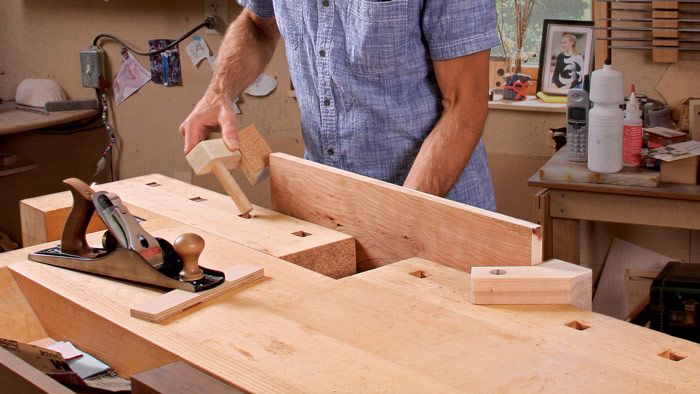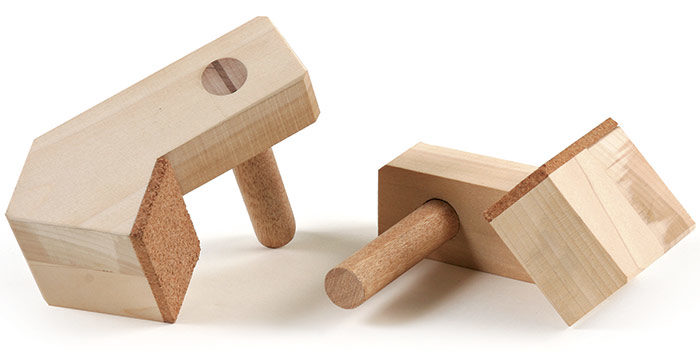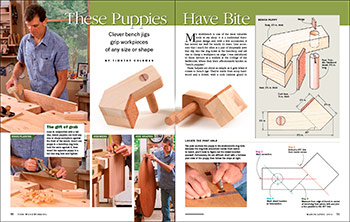These Puppies Have Bite
Clever workbench jigs grip workpieces of any size or shape.

Synopsis: Bench puppies—shopmade jaws that slip into the dogholes in a workbench and tail vise to clamp a workpiece on edge—are as simple as they are ingenious. Made from scrap hardwood and a dowel, with a cork face to protect the workpiece and discourage slipping, they work in pairs to grab both ends of a workpiece and hold it against the front of the bench. They can hold any shape, from a long board, to a door, to a drawer, or an odd-shaped piece. Once you’ve made a pair, you will wonder how you ever did without them.
My workbench is one of the most valuable tools in my shop. It is a traditional European design and, with a few accessories, it has served me well for nearly 30 years. one accessory that I reach for often is a pair of shopmade jaws that slip into the dog holes in the benchtop and tail vise to clamp a workpiece on edge. I was introduced to these devices as a student at the College of the redwoods, where they were affectionately known as “bench puppies.”
 These helpers are about as simple as it gets when it comes to bench jigs. They’re made from scrap hardwood and a dowel, with a cork cushion glued to the clamping faces to protect the workpiece as the puppies bite down.
These helpers are about as simple as it gets when it comes to bench jigs. They’re made from scrap hardwood and a dowel, with a cork cushion glued to the clamping faces to protect the workpiece as the puppies bite down.
The problem with a tail vise is that its grip is limited. It often leaves one end of a workpiece unsupported, and it doesn’t easily hold odd-shaped pieces or drawers for planing. Bench puppies step in to stretch the clamping limits of the tail vise. They grab both ends of the workpiece and hold it against the front of the bench. They’ll hold any shape workpiece, whether it’s a long board that needs edge-planing, a door that needs fitting, or an odd-shaped piece that needs fine-tuning with hand tools. They even grip drawers securely.
The hardest part about making them is putting the dowel in the right spot. The location will vary based on the distance between the dog holes and the front edge of your bench. You’ll also need to make two of them, a right- and left-hand puppy. Make sure you label each one, so you don’t end up with two righties or two lefties.
Start with two hardwood blocks for each puppy, one for the body and one for the heel. Use a full-size drawing to lay out the shape on the body, and to mark for the dowel location. Cut out the shape on the bandsaw and drill the hole using a Forstner bit. Glue the heel to the body, and then add the dowel and wedge. You don’t have to spend a lot of time sanding the body. I simply break the hard corners with a sanding block. Finally, glue the cork pad to the jaw. You can get cork from almost any office-supply store. That’s it. The puppies are ready for business.
Once you’ve made and used these, you will have reached clamping nirvana.
 From Fine Woodworking #253
From Fine Woodworking #253
To view the entire article, please click the View PDF button below:
Fine Woodworking Recommended Products

Incra Miter 1000HD

Woodriver Circle Cutting Jig

Hedgehog featherboards








Log in or create an account to post a comment.
Sign up Log in